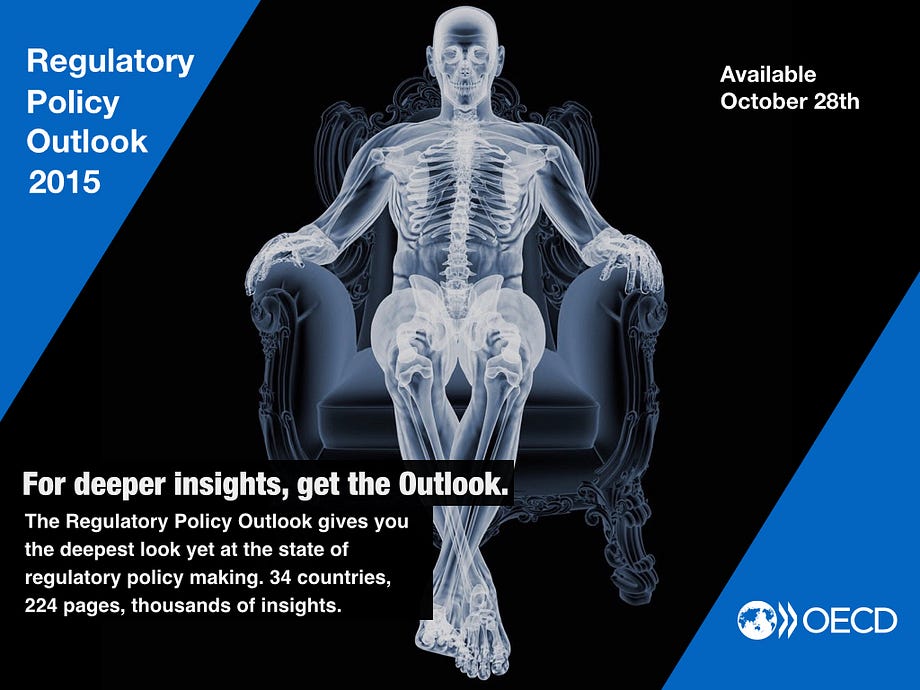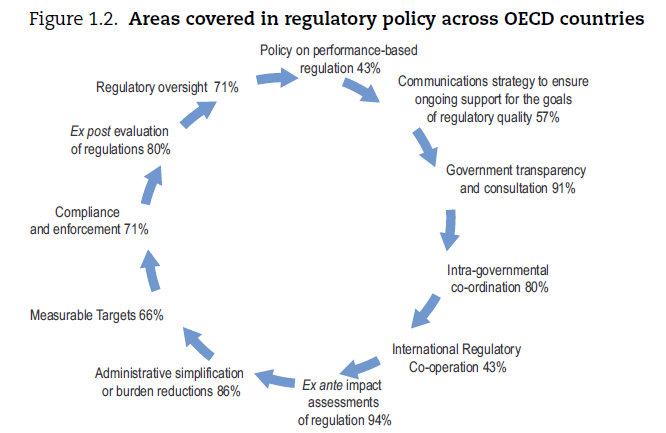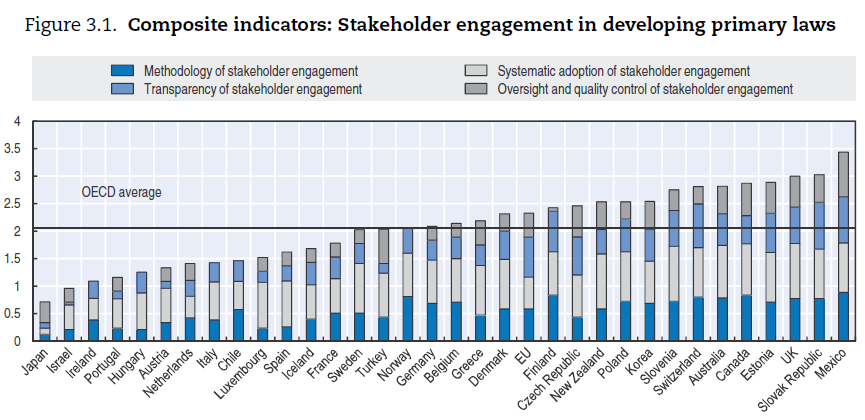The OECD way of defining “good regulation” has traditionally been pro-business, pro-trade. But things could change. Hopefully.
In October 2015 the OECD released the first edition of a new publication: the Regulatory Policy Outlook. The report develops at length the good practices that should govern “regulatory quality” based on a tryptic: regulatory impact assessment, stakeholder engagement, ex-post evaluation.

The framework advocated by the OECD is in fact a bit more complex than that, as shown by the following figure — but essentially these are the three key steps of quality regulation.

The report is also the culmination of over twenty years of OECD work on regulatory quality. It all began in the 1990s and a first set of guidance, the Recommendation on Improving the Quality of Government Regulation in 1995. That was followed by the 1997 Recommendations for Better Regulation, the 2005 Guiding Principles for Regulatory Quality and Performance and lately, the 2012 Recommendation on Regulatory Policy and Governance. The full list of OECD official texts on regulatory quality can be found here.
The OECD work has been a major source of inspiration for a number of member states but also for other international and regional bodies. There is the better regulation agenda of the European Commission, now rebranded smart regulation. There are the close ties with the World Bank Doing Business scoreboard of course. The OECD has also found support in Asia with the agreement in 2005 on a joint APEC-OECD Integrated Checklist on Regulatory Reform.
Throughout the years the main concern for the OECD has been to cut red tape for private businesses and to ensure that regulation at large — whatever the sector, whatever the level: local, national, international — would not hamper trade liberalisation and market competition. Quality regulation, we were told, has to be pro-business and it has to be anti-protectionist. For the 2005 Principles for instance, the right thing to do is to “eliminate […] economic regulations in all sectors […] except where clear evidence demonstrates that they are the best way to serve broad public interests”. The text further elaborates on the need to “eliminate unnecessary regulatory barriers to trade and investment through continued liberalisation and enhance the consideration and better integration of market openness”.
Ten years later, these unnecessary regulatory barriers are at the heart of the negotiations on a transatlantic trade and investment partnership (TTIP). A draft TTIP chapter on regulatory coherence was leaked by Corporate Europe Observatory in January 2015. The Dutch NGO has since reported regularly on the negotiations and has just released a report exposing the concerns around TTIP and the right of governments to regulate (Dangerous Regulatory Duet, January 2016). TTIP is just one example. Regulatory coherence issues are featured in many EU trade agreements, they are also part of the negotiations on the Transpacific Partnership (TPP).
Unsurprisingly, the topic is back in the OECD conference rooms. In the past two years, several meetings have been held between trade and regulatory experts, including in November 2015. Regulations, such as local content requirements, are suspected to be designed deliberately to protect domestic producers. Some would want the OECD to become a forum “to change the hearts and minds of regulators” and to “push the envelope” in determining what is an “un-necessary regulation”.
Trade unionists get seriously concerned when they hear that sort of language. Surely a plethora of regulations can come with significant, and unreasonable costs for businesses, and for small businesses in particular, and hence for employment. But the proposition that the burden of proof of what amounts to a “necessary” regulation be reversed, that a good regulation is a dead regulation unless there is “clear evidence” that demonstrates the public interest, as the 2005 Principles suggest, is a dangerous proposition. It is also a dangerous proposition to suggest that the right to regulate, and what defines good regulation should be subordinated to free trade and investment, something that would become reality should regulatory coherence be subject to investor-state dispute settlement mechanisms.
Even if we make abstraction of the broader trade and investment agenda, the regulatory quality agenda that has been put forward by the OECD, but also by the European Commission and by the World Bank, is of concern still. In principle regulatory quality and cutting red tape should benefit all: businesses, but also consumers, public administrations and their employees, private sector workers and ordinary citizens. In practice, it has been serving business groups first and sometime business groups only. For the ETUC, the European better regulation package “adds bureaucracy, slows down progressive change and de-democratises Europe and the question of what constitutes good regulation should not be solely dependent on whether the rules are associated with administrative or economic costs”.
That has fueled the perception of a double standard: reducing burden for private businesses (believed to be the only engine of growth), but not necessarily for other constituencies. There is a simple example of such double standard. The previous Canadian government launched a Red Tape Reduction Action Plan in 2012 which was then presented as a “game-changer for doing business in Canada”. While reducing reporting requirements for Canadian private businesses was central to this Action Plan, the very same government was at the very same time pushing for new a bill in parliament, C-377, that would have loaded Canadian trade unions with Kafkaesque reporting requirements, including reporting to tax administration and making public any transaction above $5000,- as well as detailed spendings related to legal actions and collective bargaining … Following the elections and change of government end-2015, the bill was repealed days ago.
The OECD will naturally object to any suggestion that its views could possibly suffer any sort of pro-business, pro-trade bias. And indeed, the OECD narrative post-2008 seems to put greater emphasis on stakeholders and citizens, on the governance of regulatory quality and on preventing regulatory capture. What regulation contains matters still, but how the regulator interacts with the regulatee matters as well. The latest 2012 Recommendation on Regulatory Policy and Governance has that post-crisis taste, with its emphasis on stakeholder consultation and “citizen engagement”. This is also how the new Regulatory Policy Outlook series can be interpreted: an attempt to broaden the perspective and indeed to make sure regulatory quality is about quality for all, not just for business-the-only-engine-of-growth-and-well-being-in-society. The report actually acknowledges social dialogue (between trade unions and employer groups) as a form of stakeholder engagement — a world première — with examples taken from the ILO, the EU, Germany, Belgium and even South Africa.
But there is room for improvement. Social dialogue is indeed mentioned in the OECD Outlook report; but we are still far away from a formal recognition in the OECD regulatory quality package. The way the OECD measures the quality of stakeholder engagement among member states is indicative. The results, presented in the form of composite indicators and shown below, come with a bit of surprise from a trade union perspective. Mexico, according to that measurement, has a top notch stakeholder engagement framework, unlike Japan, Portugal, Austria or the Netherlands which, apparently, couldn’t care less about stakeholders.

Clearly that is not the case. The explanation might be found in the OECD methodology for measuring stakeholder engagement which ignores social dialogue mechanisms. As a result, Nordic and Western European countries compare unfavourably with Anglo-American and with Eastern European countries.
Ensuring regulatory quality for all, not just for private businesses and international trade, is work in progress at the OECD. A positive step in that direction might be found in revisiting social dialogue practices and beyond that, and more simply, collective bargaining, as important forms of stakeholder engagement that work well, that have stood the test of time and that can deliver regulatory quality.
